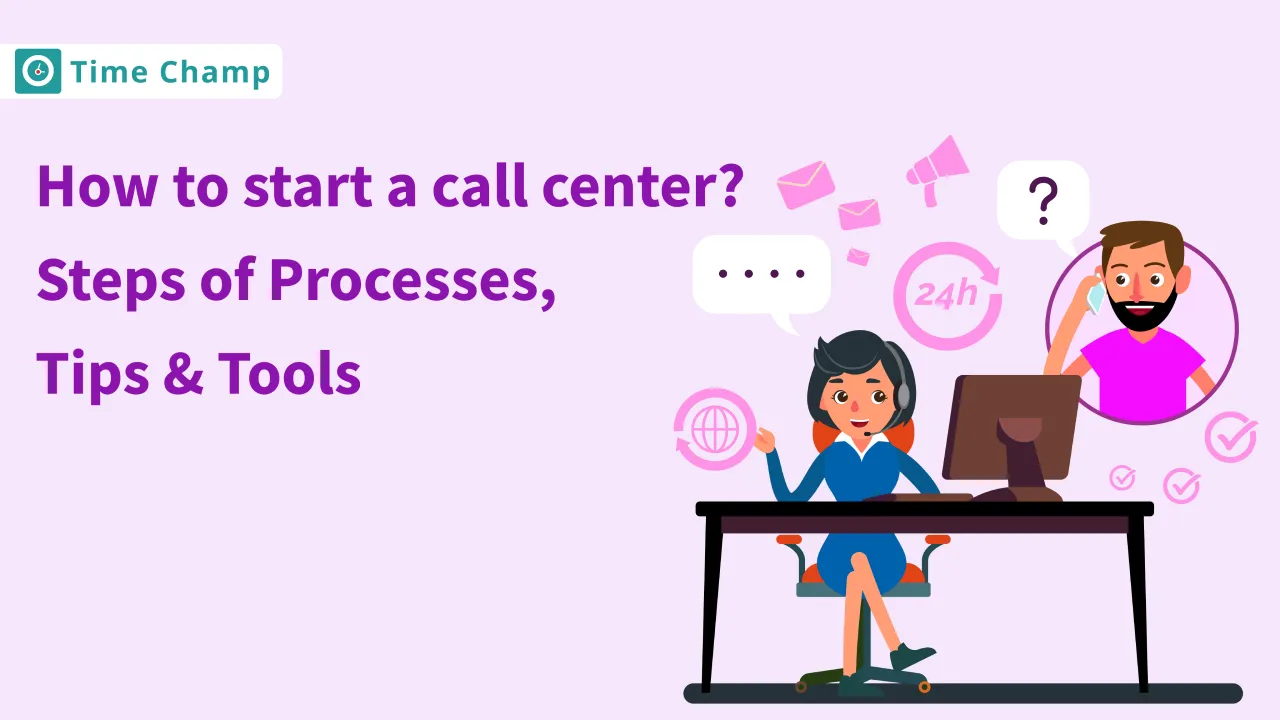Imagine having a bustling call center as the heart of your business, pulsating with energy and connecting you with customers from all corners of the world. Sounds thrilling, right? But, how do you transform this dream into reality? How to start a call center? Fear not! This guide will help you through the maze of setting up your very own call center.
In this blog, we will discuss:
1. Planning to set up your call center:
A. Decide the setup and the focus type of your call center
B. Decide
your company business goals
c.
Find a suitable location
D.
Deal with the paperwork
E.
Estimate and Establish a budget
2. Hiring the right people for your call center
3. Right tools for your call center
A. Business phone system
B. CRM (Customer relationship management) system
C. Internal communications system
D. Performance monitoring tool
So, let’s dive into the details
Planning to Set Up Your Call Center
1. Decide the Setup and the Focus of Your Call Center Type
A. Type of a Call Center Setup:
On-site Call Centers: Traditional on-site call centers located in physical offices. This is where your team works in one roof making it easy to supervise, have collaboration, and a uniformed work environment. There is also the advantage of using on-site call centers where there is onsite training and instant feedback.
On the other hand, they are associated with high operational costs because of the rent or lease of office, and the machines necessary for working which require power. Other issues include accessibility, parking, and the local labor laws.
Virtual Call Centers: The modern and flexible approach to call centers is embodied by the virtual model. Agents can work remotely in their homes supported by cloud-basedon-site call center software . This setup enables you to access a bigger pool of skills, thereby potentially saving on office space and utility costs. Virtual centers are flexible and responsive.
However, they require robust technology infrastructure and effective remote management strategies. Examples of challenges that are experienced in a remote work environment include, fostering teamwork, tracking performance, and data protection.
B. Focus Type
Inbound Call Centers: These centers handle incoming calls from customers. These call centers mainly focus on customer service, technical support or handling inquiries.
In this case, it is important to satisfy the customer and resolve the queries. Moreover, agents must have a good knowledge of the products, solve problems promptly, and communicate excellently.
Outbound Call Centers: Outbound centers focus on calling customers. They usually target at sales, lead generation, market research, and customer feedback.
For a successful outbound call center, the right sales method must be employed. Besides, the ability to communicate effectively and knowledge on customer behaviour are critical.
C. Decide Industry:
Industry specialization allows you to customize your call center services to specific market demands. In this case, a healthcare-oriented call center must understand medical terms and comply with the laws governing the health industry. On the other hand, the call centers for marketing agencies need to have good product knowledge and have to reach out to the customers directly.
Before settling on a particular industry, thoroughly research market trends as well as the types of clients with whom you are most comfortable working to determine the type of business that will come their way.
2. Decide Your Company Business Goals
The operations and strategies of your call center will be determined by your business goals. Take for instance, if you want to improve customer satisfaction, your KPIs could be call resolution time and customer feedback scores.
On the other hand, if sales growth is the objective, then sales conversion rates and outbound call metrics will be of greater importance.
Creating business goals is a fantastic way to level up your business because it breaks your progress down into small achievable parts. You can continuously work at your goals to grow your small business consistently.
3. Find a Suitable Location
The location of a call center can have a considerable effect on its success. On-site centers must consider the labor market, accessibility, and cost of living.
Time zone differences and internet connection should be considered for virtual centers.
Outsourcing is a cost-effective alternative because outsourcing to countries like the Philippines can greatly reduce setup and labor costs.
Though outsourcing is a cost-effective alternative, it involves consideration of language skills and cultural differences.
4. Deal with the Paperwork
This entails applying for appropriate licenses, following the set rules of the industry and meeting the set legal requirements. It’s crucial to consult with legal experts to navigate this complex area.
5. Estimate and Establish a Budget
Your cost should include investment capital for infrastructure and technology including office equipment, high-speed internet, software, etc., and personnel costs consisting of salaries paid and trainings undertaken as well as operating expenses. They should consider startup costs as well as operating expenses.
A budget is an effective plan to ensure that resources are channeled appropriately without necessarily incurring significant costs. So, plan your budget carefully by considering all the costs.
Getting the right people for your call center.
The quality of your team determines your call center’s success.
1. Decide How Many Employees You Require
The number of employees you require to hire depends on the anticipated call volume, the type of calls (inbound or outbound), and your operating hours. Estimate staffing needs using benchmarking on the industry, and call volume probabilities.
You need to carefully hire the right number of employees to scale up your business. But, if you hire too many employees, you have to face labor unnecessary costs. If you hire very few employees and you will be understaffed and may miss your targets.
Consider getting a balanced mix of trainees and experienced agents. Your experienced workers can guide your trainees on tasks in order to keep your business running efficiently.
2. Start a Recruitment Process
Hire people who have good communication,customer service orientation, and are stress tolerant. Specifically, look for expertise related to specific industries.
Always customize the recruitment process based on your call center setup type. If you are setting up an on-site call center, it is better to hire agents from the local regions. However, if you are setting up a virtual call center you can access a large talent pool and take advantage of time-zone differences by hiring agents from various locations in the world.
The skills tests, employment interviews, and criminal backgrounds check should be parts of the recruitment process.
3. Establish Training Programs
The training should include product knowledge, call handling, customer service skills, and technology use. To sustain quality and ensure flexibility, continuous training and development are crucial.
Right Tools for your Call Center: Unpacking the Essentials
Choosing the appropriate technology for your call center is not just about following current trends; rather, technology should be tailored to your business vision, boost efficiency, and allow for future adjustments.
A. Business Phone System:
Every day A call centre handles a very large number of calls. However, your standard phone system cannot handle such a huge number of calls. In order to handle this high call volume, you have to invest in a dedicated business phone system.
1. PBX (Private Branch Exchange):
PBX acts as the backbone of traditional call center telephony.It is essentially a private telephone network within a company.
Provides an effective method for internal routing of calls, as well as handling external calls. Suitable for enterprises that favor a tough, proven communication environment.
As for PBX systems, they are quite reliable but expensive, requiring a lot of hardware purchases and installation costs in some cases. It is also an expensive process as they need maintenance and flexibility.
2. IP PBX (Internet Protocol Private Branch Exchange):
Instead of the usual PBX call routing, we have the new look of IPPBX, the modern version.
IP PBX has advanced features such as voicemail to email, call forwarding, and integration with other digital applications. It’s highly scalable and flexible just like any business growth or downsizing process.
IP PBX provides more functionalities, though it requires a reliable and strong internet connection. Initial setup may need professional inputs, particularly when merging with current IT infrastructure.
3. Virtual VoIP (Voice over Internet Protocol):
Through VoIP , you can place calls using the internet rather than the traditional method with a telephone line.
This is very flexible and expandable that suits the call centers which are virtual or growing. The fact that it normally uses reduced operational costs compared to traditional phone systems and can be done from a distance is known as VoIP.
The quality of your internet connection has a big impact on VoIP’s performance. The calls are also made through the internet hence good cybersecurity is needed.
2. CRM (Customer Relationship Management) System:
CRM systems are tools used by businesses to track, monitor, and analyze customer interactions, preferences, and data over time.
It mainly aims at developing cordial customer-service relations, customer retention, and generating sales leads. The data collected for the customers from various sources, such as the firm’s website, telephone, live chat, direct mail, marketing materials, and even social media is combined in this system.
Using a CRM with email marketing software takes this a step further by enabling businesses to not only manage customer data but also create and send personalized email campaigns, automate follow-ups, and track engagement all from one integrated platform.
A CRM system offers a company view of each customer’s journey by enabling businesses to personalize interactions with customers, anticipate their needs, optimize processes, and increase customer satisfaction.
Choosing a CRM that integrates well with your other systems and meets your specific business needs is essential. Training is also required to ensure your team can fully leverage its capabilities.
3. Internal Communications System:
It is an important tool for easy communication among your team, especially in virtual settings.
The tool facilitates real-time collaboration, information sharing, and develops the team unity. May incorporate components such as texting, video calling, and document sharing.
You need to pick a system that users can easily handle while ensuring it complements other business tools in a hassle-free manner.
4. Performance Monitoring Software
The software application used to monitor employees’ performance as they carry out their work is called a performance monitoring tool. Such tools are very important in a call center where agents have to be busy, attentive, and engaged. These tools enable managers to analyse different aspects of work, for example, the number of calls received for a given period, the duration of each call, and an employee’s general productivity. These insights assist in making informed decisions on staffing, training, and process improvements.
What is Time Champ?
Time Champ is an advanced time and productivity tracker. This is a tool intended to track worker activities and offer real-time information on their work styles.
- Real-Time Reports: Time Champ offers real-time reporting capabilities, allowing call center managers to get up-to-date insights into team performance.
- Productivity Analysis: Time Champ has the ability to monitor the tasks and applications that the employees use during their working time. This analysis enables managers to determine whether employees are focusing their time on appropriate tasks or if there are any distractions on which they are focusing their time, such as gossiping, and hence take corrective measures if that is the case.
- Maintaining Employees Active and Focused: The tool can track active working hours and detect idle or inactive time. In a call center, this ensures that employees are effectively engaged during their shifts, contributing to overall productivity and efficiency.
- Audio Tracking: Time Champ also offers audio tracking features. Audio tracking can be helpful in monitoring quality assurance, whereby customers’ interactions should be up to standard, and for training purposes to enhance communication.
- Performance monitoring tools like Time Champ play a crucial role in optimising the efficiency and effectiveness of a call centre. They provide valuable data that can be used to improve various aspects of call centre operations, from individual agent performance to overall Project management.
Conclusion
Setting up a call center is a significant but rewarding endeavor. Through careful consideration of each facet, from planning to technology, you can develop a call center that will not only meet your objectives but also provide great service to your clients. Always bear in mind that a properly-equipped call center armed with capable personnel has the potential to turn your call center into your greatest customer care asset and growth booster.
Don’t forget to explore Time Champ for effective employee monitoring, especially if you’re venturing into outsourcing.
Frequently Asked Questioons
Starting a call center involves several steps: deciding on the type (on-site or virtual), focus (inbound or outbound), industry specialization, defining business goals, choosing a location, handling paperwork, budgeting, hiring the right team, and selecting the appropriate tools and technology. For a complete guide read the blog.
A call center operates by handling large volumes of telephone calls. Inbound centers focus on receiving calls from customers, while outbound centers are dedicated to making calls for purposes like sales, lead generation, or customer updates. Technology like PBX systems, VoIP, and CRM tools are used to manage and streamline these operations.
A call center manages customer interactions on behalf of a business. This includes providing customer support, answering queries, offering product information, conducting surveys, and making sales calls. They are pivotal in managing customer relationships and enhancing customer satisfaction.
Work in a call center includes handling calls, resolving customer queries, providing information or support, making sales pitches, recording call details, and maintaining customer interaction records. Agents need to be skilled in communication, problem-solving, and product or service knowledge.
Call center outsourcing involves hiring a third-party service provider to manage your call center operations. This can include customer service, telemarketing, or technical support. Outsourcing can reduce costs, provide access to specialised expertise, and allow businesses to focus on core functions.
Opening a call center requires strategic planning, understanding of the call center process, obtaining the necessary technology and equipment, hiring and training staff, and ensuring legal and regulatory compliance. It’s important to establish clear objectives and a solid operational plan.
Challenges include managing the technological infrastructure, hiring and retaining skilled staff, ensuring high-quality customer service, dealing with high call volumes, and maintaining operational efficiency. Adapting to changing customer needs and technology trends is also crucial.
Quality can be ensured through regular training, monitoring calls for performance, gathering customer feedback, implementing quality control measures, and using advanced tools for analytics and reporting. Fostering a customer-centric culture and continuously improving processes are key.







